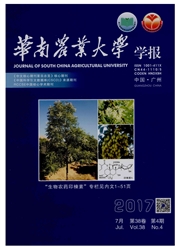

 中文摘要:
中文摘要:
【目的】调查猪场及周边环境中大肠埃希菌Escherichia coli对消毒剂和抗生素耐药情况,分析消毒剂抗性与抗菌药耐药之间的关系.【方法】从广东省某猪场采集130份样品,包括养殖场各阶段猪的粪便、猪场周边环境(猪舍空气、池塘水、周边土壤样品)以及猪场人员的粪便样品.采用选择性培养基分离鉴定大肠埃希菌,琼脂稀释法测定大肠埃希菌对4种消毒剂和10种抗菌药的MIC值,PCR法检测qac E、qac E△1、qac F、qac G、emr E、sug E(c)、sug E(p)、mdf A和ydg E/ydg F消毒剂抗性基因.【结果和结论】130份样品中共分离到97株大肠埃希菌,分离率达74.6%.受试菌株对4种消毒剂表现出不同程度的抗性,不同来源的菌株对季铵盐类消毒剂苯扎氯铵和十六烷基三甲基溴化铵都表现出较高的抗性水平,而对双胍类消毒剂三氯生和氯己定则较为敏感.87.6%(85/97)的大肠埃希菌菌株表现为多重耐药,68%-88%的菌株对磺胺甲恶唑/甲氧苄啶、多西环素、萘啶酸、头孢噻肟和氟苯尼考等抗菌药表现出耐药.消毒剂抗性基因的检出率不高(2.1%-20.6%),其中检出率最高的为qac E△1.大肠埃希菌对季铵盐类消毒剂的抗药性与抗菌药耐药性呈正相关,消毒剂抗性基因与一些特定的抗生素耐药表型也存在一定关联.在磺胺甲恶唑/甲氧苄啶、萘啶酸、环丙沙星、头孢西丁、阿米卡星和黏菌素耐药菌株中,消毒剂抗性基因检出率分别高于其敏感菌株的检测率.抗生素-消毒剂联合耐药给周边环境带来了风险,因此养殖场消毒剂和抗生素应规范使用,以减少细菌耐药性的产生.
 英文摘要:
英文摘要:
【Objective】The prevalence of disinfectant resistance genes and the relationship between resistance to disinfectants and antibiotics in Escherichia coli recovered from the swine and farm environment were investigated. 【Method】A total of 130 samples collected from swine manure, air, pond water, soil and farm workers were screened for the presence of qacE, qacE△1, qacF, qacG, emrE, sugE(c), sugE(p), mdfA and ydgE/ydgF resistance genes. The susceptibilities of E. coli strains to four disinfectants and ten common antibiotics were determined using the agar dilution method. 【Result and conclusion】 Ninety-seven strains of E. coli were obtained from 130 samples with detection frequency of 74.6%. All E. coli isolates showed reduced susceptibility to four disinfectants. The minimum inhibitory concentrations (MICs) of benzalkonium chloride (BC) and cetyltrimethy ammonium bromide (CTAB) against E. coli were higher than those of triclosan (TCS) and chlorhexidine (CL). The percent of E. coli strains, which displayed multi-drug resistant phenotypes,was 87.6% (85/97), and the resistance rates of sulfamethoxazole/trimethoprim (S/T), doxycycline(DOX), nalidixic acid (NAL), cefotaxime (CTX) and florfenicol (FFC) were high(68%-88%). However, the disinfectant resistance genes were less prevalent (2.1%-20.6%), with the most prevalent of qacE△1 found in 97 E. coli strains. There was a positive correlation between antimicrobial resistance and high MICs of quaternary ammonium compounds. The close relationship between the detection rate of disinfectant resistance genes and six antimicrobials resistance in E. coli strains was found, which resisted S/T, NAL, ciprofloxacin (CIP), cefoxitin (FOX), AMK and CS, respectively. The co-resistance E. coli poses a challenge to environmental management. Therefore, regulation of using antibiotics and disinfectants is urgently needed in order to slow down the emergence of drug-resistant bacteria.
 同期刊论文项目
同期刊论文项目
 同项目期刊论文
同项目期刊论文
 期刊信息
期刊信息
